Abstract:
In this modern age, civil engineering constructions have their own structural and durability requirements. Fiber Reinforced Concrete (FRC) is a composite material made primarily from hydraulic cements, aggregates and discrete reinforcing fibers. Fiber incorporation in concrete, mortar and cement paste enhances many of the engineering properties of these materials such as fracture toughness, flexural strength, resistance to fatigue, impact, thermal shock and spalling.
In this modern age, civil engineering constructions have their own structural and durability requirements. Fiber Reinforced Concrete (FRC) is a composite material made primarily from hydraulic cements, aggregates and discrete reinforcing fibers. Fiber incorporation in concrete, mortar and cement paste enhances many of the engineering properties of these materials such as fracture toughness, flexural strength, resistance to fatigue, impact, thermal shock and spalling.
The SFRC is a composite material made of cement, fine and coarse aggregates and discontinuous discrete steel fibers. Recently developed an analytical model to predict the shear, torsional strength and bending torsion behavior of fiber reinforced concrete beam with experimental substantiation. However, very little work has been reported in combined torsion and shear. Similarly to beam with conversional reinforcement, the presence of shear may significance influence on torsional strength of fiber concrete beams. Present paper investigates the mechanical properties like as shear strength, and torsion strength of concrete with different types of steel fiber with constant volume fractions and different aspect ratio.
Key words: Aspect ratio, Fatigue, Flexural strength, Fracture toughness, Mechanical properties, Spalling, Volume fraction.
1. Introduction
Concrete consumption is around 10 billion tons per year, which is equivalent to 1 ton per every living person. Production of Cement and Steel has environmental hazards due to emission of CO2 and dust particles in the atmosphere. Hence prudent use of cement and steel has distinct economic and environmental impacts.
1. Introduction
Concrete consumption is around 10 billion tons per year, which is equivalent to 1 ton per every living person. Production of Cement and Steel has environmental hazards due to emission of CO2 and dust particles in the atmosphere. Hence prudent use of cement and steel has distinct economic and environmental impacts.
Plain concrete is a brittle material. Under impact and dynamic loading plain concrete exhibits extensive cracking and undergoes brittle failure. The concrete is weak in tension and hence to overcome this problem cement concrete is reinforced using steel bars and thus called as reinforced concrete (R.C.) In this modern age, civil engineering constructions have their own structural and durability requirements. Every structure has its own intended purpose and hence to meet this purpose, modification in traditional cement concrete has became mandatory.
Fiber Reinforced Concrete (FRC) is a composite material made primarily from hydraulic cements, aggregates and discrete reinforcing fibers. Fiber incorporation in concrete, mortar and cement paste enhances many of the engineering properties of these materials such as fracture toughness, flexural strength, resistance to fatigue, impact, thermal shock and spalling. The use of fiber reinforcement is not a particularly recent idea. During ancient times, fibers extracted from organic material were used. Fiber Reinforced Concrete started to come to its modern industrial use during the 1960’s. Nowadays, it is commonly applied in shotcrete, pavements, industrial floors, bridge decks and precast elements.
Technically, it is possible to produce FRC of very high tensile strength using high fiber content but it is not feasible for structural applications due to practical reasons. E.g. the use of high fiber content leads to severe reduction of the workability of the fresh concrete. FRC is limited to applications where crack distribution and reduction of crack widths is the main purpose. However, the combined use of FRC and re-bars may yield synergetic effects due to improved bond properties. The use of FRC as a building material has been the target of extensive research during the last decade but still the resulting impact on existing building codes is sparse. The SFRC is a composite material made of cement, fine and coarse aggregates and discontinuous discrete steel fibers. The SFRC possess many excellent dynamic performances such as high resistance to explosion and penetration as compared to traditional concrete. When used in structural applications, SFRC should only be used in a supplementary role to inhibit cracking, to improve resistance to impact or dynamic loading and resist material disintegration.
The mechanical properties of SFRC are influenced by the type of fiber, aspect ratio, and volume fraction of fibers and the size of the aggregates. Among the various types of fiber currently available, steel fibers are most widely used. Considerable research had been carried out to evaluate mechanical properties such as tensile, compressive, flexural, and impact strength of steel fiber reinforced cement composites.
Recently, research interest has been directed toward understanding the torsional phenomenon as well. Several reports of investigations have appeared describing the improvement in strength under pure torsion and combined torsion and bending of concrete when fiber includes. Recently developed an analytical model to predict the shear, torsional strength and bending torsion behavior of fiber reinforced concrete beam with experimental substantiation. However, very few works has been reported in combined torsion and shear. Similarly to beam with conventional reinforcement, the presence of shear may influence on torsional strength of fiber concrete beams.
The objective of this paper is to investigate the mechanical properties like as shear strength, and torsion strength of concrete with different types of steel fiber with constant volume fractions and different aspect ratio.
2. Methodology
In the beginning all basic tests are conducted on all ingredient material of concrete, viz. cement, fine aggregate, coarse aggregate, water and steel fibers. ACC 43 grade cement conforming to IS 12269 – 1987 is used. River sand is used as fine aggregates, obtained from local river bed. Crushed black trap basalt is used conforming to IS 383 – 1970 of size 10 to 20 mm is used. Sulphonated Naphthalene formaldehyde polymer is used as superplasticizer having brand name as MasterPlast SPL – 9. The dose of superplasticizer is 4% of weight of cement.
In the beginning all basic tests are conducted on all ingredient material of concrete, viz. cement, fine aggregate, coarse aggregate, water and steel fibers. ACC 43 grade cement conforming to IS 12269 – 1987 is used. River sand is used as fine aggregates, obtained from local river bed. Crushed black trap basalt is used conforming to IS 383 – 1970 of size 10 to 20 mm is used. Sulphonated Naphthalene formaldehyde polymer is used as superplasticizer having brand name as MasterPlast SPL – 9. The dose of superplasticizer is 4% of weight of cement.
Three type of steel fibers, hook ended (HK – 80/60) aspect ratio 80, hook ended (HK – 50/30) aspect ratio 50, crimped (CR – 50/30) aspect ratio 50, Round fibers (RD – 50/80) aspect ratio 50 and Round fibers (RD 80/130) aspect ratio 80, all conforming to ASTM A type I are used for the experimental work.
The experimental investigation consists of total 36 beam specimens casted and tested for combined shear and torsion. All beams are tested after 28 days of curing. For each type of fibre, the percentage of fibre is kept constant as 2.5%. Out of 36 beams, 6 beams are with 0% fibre content. Total 18 beams are casted with longitudinal reinforcement of 4 numbers of bars, 8 mm diameter, 2 at top and 2 at bottom.
The proportioning of concrete is maintained constant throughout the investigation. A concrete mix targeting a compressive strength of 25 MPa is used. Figure 2.1 shows the cross sectional details of the beam loading arrangement. An effective cover of 15 mm is provided for the transverse reinforcement.
The cured beams are white washed a day before testing to facilitate the crack identification. One end of the beam is supported on rollers, while the other end is supported on rigid support. This type of test setup facilitates free rotation of roller end and provides stability to the test specimen during testing. Specially made twist arms or twist angles are placed at both supports of the beam having an arm length of 0.60 m. Load on the twist arm is applied through a hydraulic jack and the loading is monitored through a proving ring attached to the jack. Absolute care has taken, such that, the plane of loading and twisting arm are perpendicular to the longitudinal axis of the beam. This avoids any possibility of bending of the beam instead of twisting and as a result the beam between the two supports is subjected to pure torsion. The complete test setup is schematically presented in figure 2.2. Load is applied at an eccentricity of 0.66 m from the center of the beam. For every applied load, the corresponding dial gauge readings are noted which were placed at L/3 distance from ends and considering average value of the two reading.
3. Observations and Results
Comparative Statement for PCC and different types of steel fibers with reinforcement (RC):
Comparative Statement for PCC and different types of steel fibers with reinforcement (RC):
3.1 Discussion:
1. In general, the significant improvement in various strengths is observed with the inclusion of hooked end steel fibres in the plain concrete as compared to crimped & straight types of steel fibre.
1. In general, the significant improvement in various strengths is observed with the inclusion of hooked end steel fibres in the plain concrete as compared to crimped & straight types of steel fibre.
2. From comparative statement of same aspect ratio:
a) Torsion strength:
i) For without reinforced members (from Table 3.1), strength comparison between same aspect ratio HK-80 & RD-80 is 25.31 kNm and 23.05 kNm respectively and HK-50, CR-50 and RD-50 is 23.95 kNm, 22.59 kNm and 19.88 kNm respectively. Refer figure 3.1
i) For without reinforced members (from Table 3.1), strength comparison between same aspect ratio HK-80 & RD-80 is 25.31 kNm and 23.05 kNm respectively and HK-50, CR-50 and RD-50 is 23.95 kNm, 22.59 kNm and 19.88 kNm respectively. Refer figure 3.1
ii) For with reinforced members (from Table 3.2), strength comparison between same aspect ratio HK-80 & RD-80 is 31.66 kNm and 28.03 kNm respectively and HK-50, CR-50 and RD-50 is 27.58 kNm, 25.76 kNm and 24.41kNm respectively. Refer figure 3.2
b) Torsional Moment:
i) Without reinforced members (from Table 3.1), strength comparison between same aspect ratio HK-80 & RD-80 is 3.84 kNm and 3.35 kNm respectively and HK-50, CR-50 and RD-50 is 3.19 kNm, 2.95 kNm and 2.87 kNm respectively. Refer figure 3.3
i) Without reinforced members (from Table 3.1), strength comparison between same aspect ratio HK-80 & RD-80 is 3.84 kNm and 3.35 kNm respectively and HK-50, CR-50 and RD-50 is 3.19 kNm, 2.95 kNm and 2.87 kNm respectively. Refer figure 3.3
ii) For with reinforced members (from Table 3.2), strength comparison between same aspect ratio HK-80 & RD-80 is 4.07 kNm and 3.82 kNm respectively and HK-50, CR-50 and RD-50 is 3.62 kNm, 3.41 kNm and 3.37 respectively. Refer figure 3.4
c) Shear strength:
i) For without reinforced members (from Table 3.1), strength comparison between same aspect ratio HK-80 & RD-80 is 5.82 kN and 5.08 kN respectively and HK-50, CR-50 and RD-50 is 4.84 kN, 4.47 kN, and 4.35 kN respectively. Refer figure 3.6
i) For without reinforced members (from Table 3.1), strength comparison between same aspect ratio HK-80 & RD-80 is 5.82 kN and 5.08 kN respectively and HK-50, CR-50 and RD-50 is 4.84 kN, 4.47 kN, and 4.35 kN respectively. Refer figure 3.6
ii) For with reinforced members (from Table 3.2), strength comparison between same aspect ratio HK-80 & RD-80 is 6.19 kN and 5.33 kN respectively and HK-50, CR-50 and RD-50 is 5.57 kN, 4.96 kN and 4.59 kN respectively. Refer figure 3.6
4. Conclusion
1. From above discussion it is conclude that, shear strength and Torsional strength are improved by addition of fibers irrespective of fiber type and aspect ratio.
1. From above discussion it is conclude that, shear strength and Torsional strength are improved by addition of fibers irrespective of fiber type and aspect ratio.
2. There is marginal improvement in torsion and shear strength of concrete with change in aspect ratio.
3. The resistance of RC and plain concrete dose not shows pronounced effect on shear and torsion strength. The reinforcement placed in the beams is in longitudinal direction; because of this the contribution of reinforcement in resistance is very less. But the addition of fibers in both type i.e. with or without reinforcement shows improvement in the shear and Torsional strength.
4. Torsional moment resistance of the hook end type fibers with and without reinforcement is very good as compare to other types of fibers, but there is very small improvement in the reinforcement due to addition of reinforcement.
5. Also it is observed that for same aspect ratio the hook ended fibre showing pronounce improvement in all properties of concrete as compare crimped & straight fiber. There is decrease in the strength with decrease in aspect ratio of same fiber type. The straight fibers having less strength as compared with hook end and crimped fibers. This is obvious that the hook end and crimped fiber because of their shape having good bond and anchorage in the matrix resulting in more strength.
References
1. Singh S.P.and Kaushik S.K.,(2003) Fatigue strength of steel fiber reinforced concrete in flexure, Cement & Concrete Composites, Vol. 25, 779–786.
2. P. N. Balaguru, and S. P. Shah, (1992), Fiber Reinforced Cement Composites, McGraw-Hill: New York.
3. J. J. Beaudoin, (1990) Handbook of Fibre Reinforced Concrete – Principles, Developments and Applications, Noyes Publications: New Jersey, USA.
4. D. J. Hannant, 1978, Fibre Cements and Fibre Concretes, John Wiley and Sons: New York, USA.
5. Had Bayasi and Henning Kaiser (2001), Steel fibers as crack arrestors in concrete, Indian concrete journal, Vol. 75, 215-219.
6. Balaguru, P. and Najm, H., (2004) High-Performance Fiber-Reinforced Concrete Mixture Proportions with High Fiber Volume Fractions, ACI Materials Journal – 2004, Vol.101, No.4, 281-286.
7. Ganesan, N., and T. Sekar.,(2006) Effect of micro-silica and steel fibers on the strength of high performance, Journal of structural engineering, India (SERC) vol.33, No.3 , 225-229.
8. Hsu, T.T.C., (1968) Torsion of structural plain concrete rectangular sections, American concrete Institute, Detroit, Special Publication SP 18, 203-238.
9. Narayanan R. and Toorani-Goloosalar. Z., (1979) Fiber reinforced concrete in pure torsion and in combined bending and torsion, Proceedings, Institution of Civil engineers, London Part2,Vol.67, 987-1001.
10. Midness S., (1980) Torsion tests of steel fiber reinforced concrete, The international journal of Cement Composites, vol.2, 85-89.
11. Narayanan R. and Green K.R., (1980) Fiber-reinforced concrete beams in pure torsion, proceedings, Institution of Civil engineers, London Part2, Vol.69, 1043-44.
12. Mansur M.A. and Paramasivam P., Steel fiber reinforced concrete beams in pure torsion, The international journal of Cement Composites and Lightweight Concrete, vol.4, No.1, 39-45.
13. Narayanan, R., and Kareem Palanjian, A.S. (1983) Steel fiber reinforced concrete beams in pure torsion, The international Journal of Cement Composites and Lightweight Concrete, vol.5, No.4, 235-246.
14. Mansur, M.A., and Lim, T.Y.,(1985) Torsional behavior of reinforced concrete beams, The international journal of Cement Composites and Lightweight Concrete, vol.7, No.4, 261-267.
15. Gunasekaran, K., P. Eapen Sakaria, and M. Lakshmipathy, (2007) Experimental Evaluation Of High Strength Concrete Beams Subjected To Pure Torsion, ICI Journal,Vol.7, No.4, 27-30.
16. Amir A. Mirsayah and Nemkumar Banthia,(2002) Shear Strength of Steel Fiber-Reinforced Concrete, ACI Materials Journal, Vol.99, No.5, 473-479.
1. Singh S.P.and Kaushik S.K.,(2003) Fatigue strength of steel fiber reinforced concrete in flexure, Cement & Concrete Composites, Vol. 25, 779–786.
2. P. N. Balaguru, and S. P. Shah, (1992), Fiber Reinforced Cement Composites, McGraw-Hill: New York.
3. J. J. Beaudoin, (1990) Handbook of Fibre Reinforced Concrete – Principles, Developments and Applications, Noyes Publications: New Jersey, USA.
4. D. J. Hannant, 1978, Fibre Cements and Fibre Concretes, John Wiley and Sons: New York, USA.
5. Had Bayasi and Henning Kaiser (2001), Steel fibers as crack arrestors in concrete, Indian concrete journal, Vol. 75, 215-219.
6. Balaguru, P. and Najm, H., (2004) High-Performance Fiber-Reinforced Concrete Mixture Proportions with High Fiber Volume Fractions, ACI Materials Journal – 2004, Vol.101, No.4, 281-286.
7. Ganesan, N., and T. Sekar.,(2006) Effect of micro-silica and steel fibers on the strength of high performance, Journal of structural engineering, India (SERC) vol.33, No.3 , 225-229.
8. Hsu, T.T.C., (1968) Torsion of structural plain concrete rectangular sections, American concrete Institute, Detroit, Special Publication SP 18, 203-238.
9. Narayanan R. and Toorani-Goloosalar. Z., (1979) Fiber reinforced concrete in pure torsion and in combined bending and torsion, Proceedings, Institution of Civil engineers, London Part2,Vol.67, 987-1001.
10. Midness S., (1980) Torsion tests of steel fiber reinforced concrete, The international journal of Cement Composites, vol.2, 85-89.
11. Narayanan R. and Green K.R., (1980) Fiber-reinforced concrete beams in pure torsion, proceedings, Institution of Civil engineers, London Part2, Vol.69, 1043-44.
12. Mansur M.A. and Paramasivam P., Steel fiber reinforced concrete beams in pure torsion, The international journal of Cement Composites and Lightweight Concrete, vol.4, No.1, 39-45.
13. Narayanan, R., and Kareem Palanjian, A.S. (1983) Steel fiber reinforced concrete beams in pure torsion, The international Journal of Cement Composites and Lightweight Concrete, vol.5, No.4, 235-246.
14. Mansur, M.A., and Lim, T.Y.,(1985) Torsional behavior of reinforced concrete beams, The international journal of Cement Composites and Lightweight Concrete, vol.7, No.4, 261-267.
15. Gunasekaran, K., P. Eapen Sakaria, and M. Lakshmipathy, (2007) Experimental Evaluation Of High Strength Concrete Beams Subjected To Pure Torsion, ICI Journal,Vol.7, No.4, 27-30.
16. Amir A. Mirsayah and Nemkumar Banthia,(2002) Shear Strength of Steel Fiber-Reinforced Concrete, ACI Materials Journal, Vol.99, No.5, 473-479.
Table 3.1 Result of Torsion, Moment and Shear without reinforcement
| Type of fiber | Torsion (kNm) | Moment (kNm) | Shear Failure Load (kN) |
| 0% | 16.26 | 2.87 | 4.35 |
| HK-80 | 25.31 | 3.84 | 5.82 |
| HK-50 | 23.95 | 3.19 | 4.84 |
| CR-50 | 22.59 | 2.95 | 4.47 |
| RD-80 | 23.05 | 3.35 | 5.08 |
| RD-50 | 19.88 | 2.87 | 4.35 |
Table 3.2 Result of Torsion, Moment and Shear with reinforcement
| Type of fiber | Torsion (kNm) | Moment (kNm) | Shear Failure Load (kN) |
| 0% | 20.33 | 2.63 | 3.98 |
| HK-80 | 31.66 | 4.07 | 6.19 |
| HK-50 | 27.58 | 3.62 | 5.57 |
| CR-50 | 25.76 | 3.41 | 4.96 |
| RD-80 | 28.03 | 3.82 | 5.33 |
| RD-50 | 24.41 | 3.37 | 4.59 |
We at engineeringcivil.com are thankful to Er. Yogesh Ravindra Suryawanshi for submitting this research paper to us. We hope this will be of great use to all other engineers who are looking forward to do more research in this field.
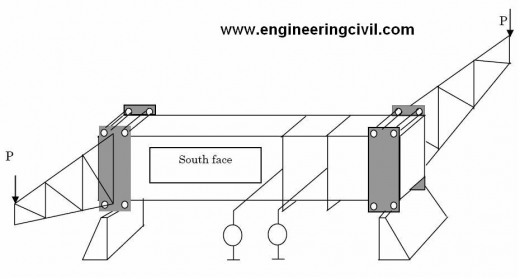
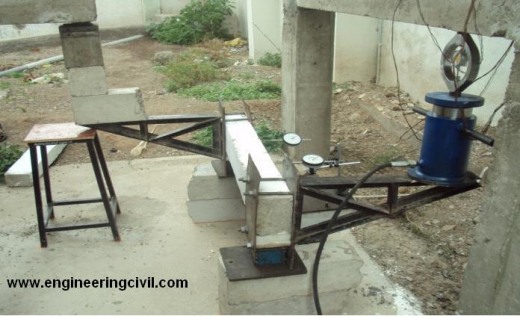
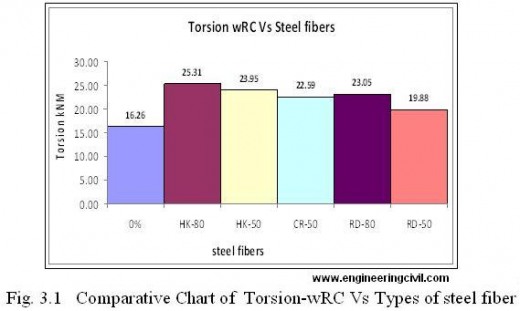
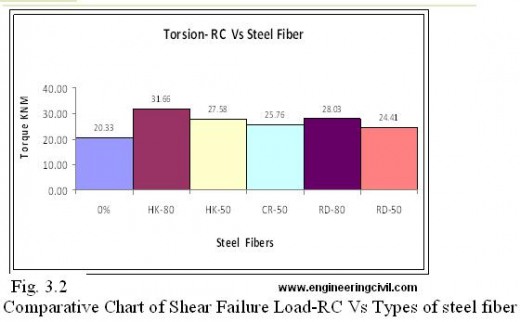
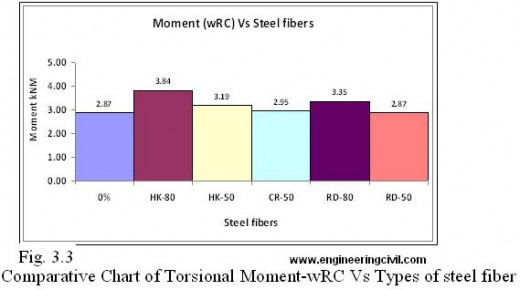
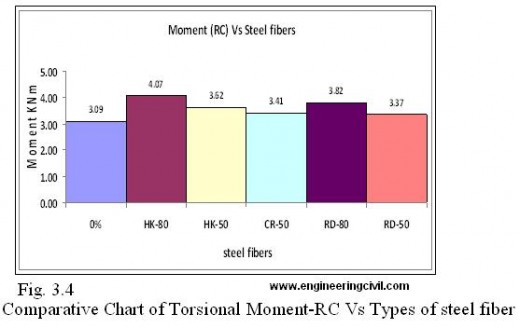
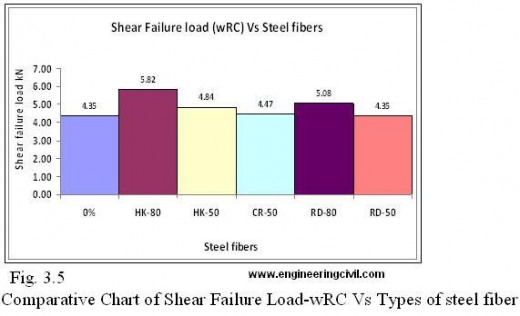
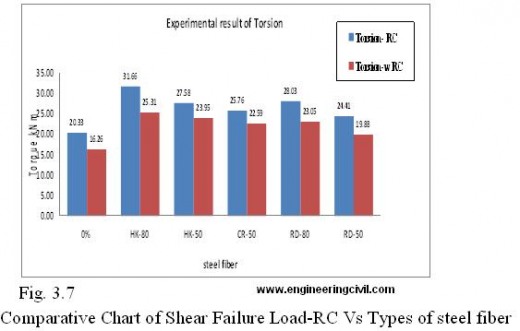
thanks to admin
ReplyDeletethanks pls subscribe us
Delete